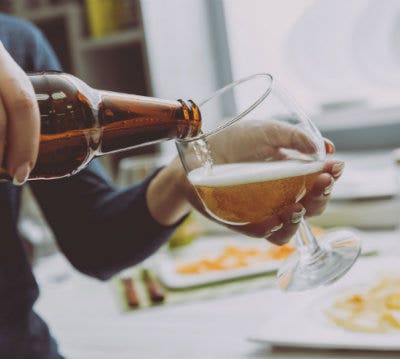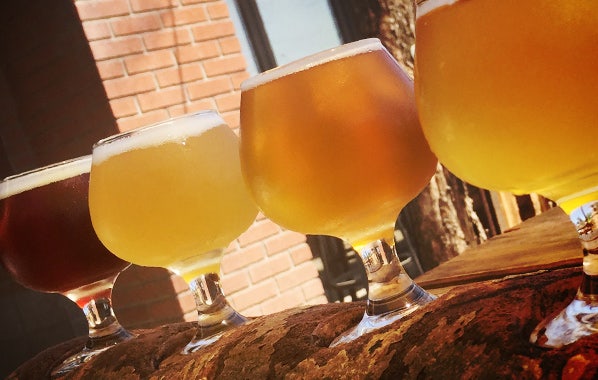How to Brew the Best Lager Recipe
Brief History of Lager
 This Bavarian brew received its name from the German verb lagern, meaning “to store,” because the key to its brewing process is cold storage. It was in the early nineteenth century that Bavarian brewers began storing their beers, brewed with bottom fermenting yeast, in cold beer cellars for long periods of time. After initial fermentation, their beer would be kept at a low temperature for a second “lagering” period, and would then be kept in a cold beer cellar. The beer was kept for weeks and then months in this cold storage, which allowed flavors to mellow, and for the beer to become clear.
This Bavarian brew received its name from the German verb lagern, meaning “to store,” because the key to its brewing process is cold storage. It was in the early nineteenth century that Bavarian brewers began storing their beers, brewed with bottom fermenting yeast, in cold beer cellars for long periods of time. After initial fermentation, their beer would be kept at a low temperature for a second “lagering” period, and would then be kept in a cold beer cellar. The beer was kept for weeks and then months in this cold storage, which allowed flavors to mellow, and for the beer to become clear.

Lager Styles
Scan our list of Lager styles to find the one with a description that best suits your taste. This will make pinning down a recipe much easier. It will also give you the added confidence that after all that brewing and conditioning you’ll be truly happy with the finished beer.
Light Lagers
American Light Lager + American Lager
These are both going to be very carbonated, light-bodied, and light in flavor (the "light lager," clearly, more so). In fact, American Light Lagers can be nearly flavorless. This light flavor is why American Light Lagers and American Lagers are best enjoyed very cold to keep them refreshing and thirst-quenching.
International Pale Lager
Much like American Light Lagers and American Lagers, International Pale Lagers are highly-attenuated, light in flavor, balanced, very carbonated, and best enjoyed cold.
"Helles" means "light" as in “pale” in German. So, you can expect that beers with "helles" in their name will be lighter in color, though not necessarily lighter in body.
Munich Helles
A German lager with a sweet, grainy, malt flavor and a soft, dry finish. Balanced, though slightly more malty, with spicy, herbal & floral hops that are minimally bitter. Refreshing and easy to drink, as with other lagers.
Helles Exportbier
Smooth, balanced, and pale beer with moderate body, aromatic hops, and malt character.
Pilsners
German Pils
Light-bodied, dry, golden beer with floral hop aroma and refreshing bitterness. The 2015 BJCP guide claims that German Pils, “showcases the finest quality German malt and hops”.
Czech Premium Pale Lager
This lager boasts bold malt and hop character, with a long finish. It has a complexity beyond the typical lager characteristics of balance and refreshment. Unique malt flavors and a strong, clean bitterness round out this beer and make it remarkably drinkable.
Historical Beer (Pre-Prohibition Lager)
The stronger bitterness and sweet corn flavor to this lager set it apart, giving it a richer flavor profile. Otherwise, this beer is clean, and refreshing like most pale lagers.
European Amber Lagers
Vienna Lager
Soft, bready maltiness, pleasant bitterness, and a dry finish make this moderate-strength lager a favorite.
Märzen
Known as the beer of Octoberfest, this malty, German amber has soft, bready maltiness and pleasant bitterness, much like a Vienna Lager, but with a dry finish and rich, complex aftertaste.
Dark Lagers
Munich Dunkel
This German lager has deep, rich, complex flavor courtesy of the Munich malts. Expect malt notes of bread, toast, and chocolate.
Schwarzbier
This German lager has a light, dry body and a flavorful balance of roasted, but smooth malt with some noticeable hop bitterness.
Bocks
Helles Bock
This bock, though pale, is strong, malty, and has bold hop character. It’s gentle, dry finish makes it very drinkable.
Dunkles Bock
Though dark, strong, and malty, this German lager stays rich and toasty without finishing too sweet.
Doppelbock
As with other bocks, this German lager will be rich, strong and malty – though it does have both pale and dark variations. The darker has richer malt flavor, while the paler of the two is dryer, and has more hop flavor.
Eisbock
A smooth, warming German lager with bold malts and body. The mouthfeel is so rich that it can often have a viscous quality.
Brewing a Lager

Lagers require bottom-fermenting yeast.
Lager yeast is especially sensitive to higher temperatures. Recommended lager yeast temperatures during fermentation can be as low as 38°F. You might want a dedicated beer refrigerator and temperature controller if you are a lager fan.
You’ll want to pitch your yeast in the 60°F - 65°F range. Once fermentation begins, you’ll need to drop the temperature of the yeast to the recommended range for the lager yeast you are using, which as previously mentioned, may be as low as 38-45°F.
After fermentation, you will once again increase the temperature (at or near 62°F) for what is known as a “diacetyl rest,” lasting 2-3 days. This will ensure that fermentation is finished, and will eliminate the remaining CO2 that tends to cause off flavors. It will also allow the yeast to absorb diacetyl produced during fermentation.
Once those 2-3 days are over, it is time to lager. Bring your temperature down in increments of 5°F a day until you reach 35°F. Lager your beer for a minimum of six weeks. Lagering will make your beer clearer (as the yeast sediment drops) and cleaner, so do not be afraid to allow it more time.
Tip: If clear beer is especially important to you, you may want to consider purchasing a clarifying agent like Irish Moss.
To learn about other styles check out our Guide to Picking the Best IPA or our Guide to Picking the Best Pale Ale.
Sources:
